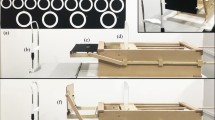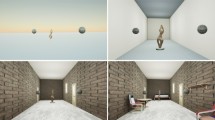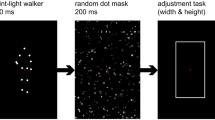Abstract
We investigated spatial perception of virtual images that were produced by convex and plane mirrors. In Experiment 1, 36 subjects reproduced both the perceived size and the perceived distance of virtual images for five targets that had been placed at a real distance of 10 or 20 m. In Experiment 2, 30 subjects verbally judged both the perceived size and the perceived distance of virtual images for five targets that were placed at each of five real distances of 2.5–45 m. In both experiments, the subjects received objective-size and objective-distance instructions. The results were that (1) size constancy was attained for a distance of up to 45 m, (2) distance was readily discriminated within this distance range, although virtual images produced by the mirror of strong curvature were judged to be farther away than those produced by the mirrors of less curvature, and (3) the ratio of perceived size to perceived distance was described as a power function of visual angle, and the ratio for the convex mirror was larger than that for the plane mirror. We compared the taking-into-account model and the direct perception model on the basis of a correlation analysis for proximal, virtual, and real levels of the stimuli. The taking-into-account model, which assumes that visual angle is transformed into perceived size by taking perceived distance into account, was supported by an analysis for the proximal level of stimuli. The direct perception model, which assumes that there is no inferential process between perceived size and perceived distance, was partially supported by an analysis for the distal level of the stimuli.
Article PDF
Similar content being viewed by others
References
Adolfson, J., &Berghage, T. (1974).Perception and performance under water. New York: Wiley.
Baird, J. C., &Wagner, M. (1991). Transformation theory of size judgment.Journal of Experimental Psychology: Human Perception & Performance,17, 852–864.
Barac-Cikoja, D., &Turvey, M. T. (1995). Does perceived size depend on perceived distance? An argument from extended haptic perception.Perception & Psychophysics,57, 216–224.
Broota, K. D., &Epstein, W. (1973). The time it takes to make vertical size and distance judgments.Perception & Psychophysics,14, 358–364.
Epstein, W. (1973). The process of “taking-into-account” in visual perception.Perception,2, 267–285.
Epstein, W. (1977). Historical introduction to constancies. In W. Epstein (Ed.),Stability and constancy in visual perception: Mechanisms and processes (pp. 1–22). New York: Wiley.
Epstein, W., &Broota, K. D. (1975). Attitude of judgment and reaction time in estimation of size at a distance.Perception & Psychophysics,18, 201–204.
Epstein, W., &Landauer, A. A. (1969). Size and distance judgments under reduced conditions of viewing.Perception & Psychophysics,6, 269–272.
Epstein, W., Park, J., &Casey, A. (1961). The current status of the size-distance hypotheses.Psychological Bulletin,58, 491–514.
Foley, J. M. (1967). Binocular disparity and perceived relative distance: An examination of two hypotheses.Vision Research,7, 655–670.
Foley, J. M. (1968). Depth, size and distance in stereoscopic vision.Perception & Psychophysics,3, 265–274.
Gibson, J. J. (1950).The perception of the visual world. Boston: Houghton Mifflin.
Gibson, J. J. (1979).The ecological approach to visual perception. Boston: Houghton Mifflin.
Gogel, W. C. (1964). Size cue to visually perceived distance.Psychological Bulletin,62, 217–235.
Gogel, W. C. (1969). The sensing of retinal size.Vision Research,9, 1079–1094.
Gogel, W. C. (1973a). The organization of perceived space: I. Consequences of perceptual interactions.Psychologische Forschung,36, 195–221.
Gogel, W. C. (1973b). The organization of perceived space: II. Perceptual interactions.Psychologische Forschung,36, 223–247.
Gogel, W. C. (1998). An analysis of perceptions from changes in optical size.Perception & Psychophysics,60, 805–820.
Gogel, W. C., &Da Silva, J. A. (1987). Familiar size and the theory of off-sized perceptions.Perception & Psychophysics,41, 318–328.
Gogel, W. C., Wist, E. R., &Harker, G. S. (1963). A test of the invariance of the ratio of perceived size to perceived distance.American Journal of Psychology,76, 537–553.
Harris, C. S. (1965). Perceptual adaptation to inverted, reversed, and displaced vision.Psychological Review,72, 419–444.
Hayashibe, K. (2002). Apparent distance in actual, three-dimensional video-recorded, and virtual reality.Perceptual & Motor Skills,95, 573–582.
Held, R., &Gottlieb, N. (1958). A technique for studying adaptation to disarranged hand-eye coordination.Perceptual & Motor Skills,8, 83–86.
Hershenson, M. (1992). Size-distance invariance: Kinetic invariance is different from static invariance.Perception & Psychophysics,51, 541–548.
Higashiyama, A. (1977). Perceived size and distance as a perceptual conflict between two processing modes.Perception & Psychophysics,22, 206–211.
Higashiyama, A., Ishikawa, T., &Tanaka, K. (1990). Visual alleys as a function of instructions under informative and reduced conditions of viewing.Perception & Psychophysics,47, 468–476.
Higashiyama, A., &Kitano, S. (1991). Perceived size and distance of persons in natural outdoor settings: The effects of familiar size.Psychologia,34, 188–199.
Higashiyama, A., &Shimono, K. (1994). How accurate is size and distance perception for very far terrestrial objects? Function and causality.Perception & Psychophysics,55, 429–442.
Higashiyama, A., Yokoyama, Y., &Shimono, K. (2001). Perceived distance of targets in convex mirrors.Japanese Psychological Research,43, 13–24.
Hubbard, T. L., Kall, D., &Baird, J. C. (1989). Imagery, memory, and size-distance invariance.Memory & Cognition,17, 87–94.
Kaess, D. W. (1980). Instructions and decision times of size-constancy responses.Perception & Psychophysics,27, 477–482.
Kilpatrick, F. P., &Ittelson, W. H. (1953). The size-distance invariance hypothesis.Psychological Review,60, 223–231.
Landauer, A. A., &Epstein, W. (1969). Does retinal size have a unique correlate in perceived size?Perception & Psychophysics,6, 273–275.
Norman, J. (1980). Direct and indirect perception of size.Perception & Psychophysics,28, 306–314.
Ono, H., O’Reiley, J., &Herman, L. (1970). Underwater distance distortion within a manual work space.Human Factors,12, 473–480.
Oyama, T. (1974). Perceived size and perceived distance in stereoscopic vision and an analysis of their causal relations.Perception & Psychophysics,16, 175–181.
Oyama, T. (1977). Analysis of causal relations in the perceptual constancies. In W. Epstein (Ed.),Stability and constancy in visual perception (pp. 183–216). New York: Wiley.
Predebon, J. (1992). The role of instructions and familiar size in absolute judgments of size and distance.Perception & Psychophysics,51, 344–354.
Rock, I. (1966).The nature of perceptual adaptation. New York: Basic Books.
Rock, I. (1975).An introduction to perception. New York: Macmillan.
Rock, I. (1984).Perception. New York: Scientific American Books.
Rock, I., &Ebenholtz, S. (1959). The relational determination of perceived size.Psychological Review,66, 387–401.
Ross, H. E. (1968). Water, fog and the size-distance invariance hypothesis.British Journal of Psychology,58, 301–313.
Ross, H. E., &Rejman, M. H. (1972). Adaptation to speed distortions under water.British Journal of Psychology,63, 257–264.
Sedgwick, H. A. (1986). Space perception. In K. R. Boff, L. Kaufman, & J. P. Thomas (Eds.),Handbook of perception and human performance (Vol. 1, pp. 21-1 to 21-57). New York: Wiley.
Teghtsoonian, M. (1970). The effects of size and distance on magnitude estimations of apparent size.American Journal of Psychology,83, 601–612.
Teghtsoonian, M. (1974). The doubtful phenomenon of over-constancy. In H. R. Moskowitz, B. Scharf, & J. C. Stevens (Eds.),Sensation and measurement: Papers in honor of S. S. Stevens (pp. 411–420). Dordorecht: Reidel.
van der Meer, H. C. (1979). Interrelation of the effects of binocular disparity and perspective cues on judgments of depth and height.Perception & Psychophysics,26, 481–488.
Vernoy, M. W. (1989). Simultaneous adaptation to size, distance, and curvature underwater.Human Factors,31, 77–85.
Vernoy, M. W., &Luria, S. M. (1977). Perception of, and adaptation to, a three-dimensional curvature distortion.Perception & Psychophysics,22, 245–248.
Vogel J. M., &Teghtsoonian, M. (1972). The effects of perspective alterations on apparent size and distance scales.Perception & Psychophysics,11, 294–298.
Wallach, H., &Zuckerman, C. (1963). The constancy of stereoscopic depth.American Journal of Psychology,76, 404–412.
Wiest, W. M., &Bell, B. (1985). Stevens’s exponent for psychophysical scaling of perceived, remembered, and inferred distance.Psychological Bulletin,98, 457–470.
Author information
Authors and Affiliations
Corresponding author
Additional information
This study was supported by research funds provided by Ritsumeikan University.
Note—This article was accepted by the previous editorial team, headed by Neil Macmillan.
Rights and permissions
About this article
Cite this article
Higashiyama, A., Shimono, K. Mirror vision: Perceived size and perceived distance of virtual images. Perception & Psychophysics 66, 679–691 (2004). https://doi.org/10.3758/BF03194911
Received:
Accepted:
Issue Date:
DOI: https://doi.org/10.3758/BF03194911




